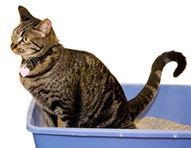

Dr Rebecca Nathan
Does your cat suffer from bladder issues?
Feline interstitial cystitis (FIC) or feline idiopathic cystitis as it’s often called is inflammation of the bladder that causes symptoms of lower urinary tract disease.
FIC can occur in both female and male cats. It is a chronic disease that can be difficult to treat and therefore frustrating for both the cat and the owner!
Symptoms of FIC can include:
Frequent attempts to urinate i.e. hopping in & out of the litter tray
Straining to urinate i.e. extended periods in the litter tray, often unproductive
Urinating in inappropriate places in the house
Crying out during attempts to urinate
Blood-tinged urine
Causes:
FIC is thought to account for around ⅔ of all cases of Feline Lower Urinary Tract Disease or FLUTD. Unfortunately the exact underlying cause is yet to be determined. The following abnormalities appear to be common in cats suffering from FIC;
Defective bladder lining - lining the cells of the bladder is a mucous layer that helps to protect the delicate cells of the bladder wall. It’s thought that in cats with FIC this layer mucous layer is deficient.
Neurogenic bladder inflammation - nerves in the bladder wall may be stimulated either by irritation to the bladder lining or, sometimes, from stimulation via the brain (for example in response to stress). Stimulation of these nerves causes increased inflammation and pain.
Stress – stress plays an important role in FIC. In many cats with FIC an episode of the disease may be triggered by a stressful event. Stress in cats can be initiated by a number of different contributing factors, some of which include; visitors staying over, a new pet, multi-cat households, pain or other illness, food/water bowl placement, litter tray placement and quantity, exercise, stimulation, diet etc
Abnormal stress responses –not only is there good evidence that stress plays a role in provoking FIC in affected cats, there is also evidence that these cats do not handle stress in a 'normal' way.
Changes similar to those described above that are seen in cats with FIC are also seen in humans with interstitial cystitis. It is currently thought that FIC may develop in certain individuals that are genetically programmed to respond to stress in a slightly abnormal way, and perhaps also have some local defect in the bladder lining. However, the precise mechanism by which FIC develops is still uncertain.
Diagnosis:
Diagnosis relies on ruling out other diseases that may cause similar symptoms, such as urinary tract infections, bladder stones, and other bladder abnormalities in cats. Tests that are commonly performed include:
A blood screen, including a complete blood count (which examines the different types of red & white blood cells circulating in the blood stream) and biochemistry profile (which is useful in evaluating the function of major organs such as the liver and kidneys)
A urinalysis which checks for abnormalities in the urine, including blood, crystals, protein and other abnormal substances as well as testing the pH (which determines how acidic the urine is), and the urine specific gravity (which determines whether the urine is concentrated or not)
An abdominal X-ray and/or an ultrasound of the bladder to rule out stones and other abnormal structures i.e. cancers in the bladder.
It has been shown that the best approach to managing cats with FIC is to use multimodal treatment. This simply means making a number of different changes to help reduce the likelihood of recurrent episodes of FIC.
Dietary Modification:
Feeding a commercial urinary diet such as Hill’s c/d Multicare Urinary Stress prescription diet has shown to reduce the recurrence of FIC signs. This diet now contains added ingredients to help manage stress. Such ingredients include L-tryptophan & milk protein hydrosyate which have been proven to reduce feline anxiety.
Encouraging more frequent urination and producing urine that is more dilute (and therefore potentially less irritating to the cells lining the bladder) appears to be helpful in FIC. This can be achieved by feeding mainly a wet food diet and encouraging increased water intake.
Controlling stress:
It is important to try to identify and modify or avoid any specific stress triggers in the environment. Where possible, if specific stress triggers are identified, they should be minimised or avoided. Have a look at the Hill’s Science Diet video clips on our facebook page for tips on managing stress in your pet cat.
Medication:
Not all cases of FIC respond to medication. Medications that your vet may suggest to trial include non-steroidal anti-inflammatories as well as behavioural modifiers such as tricyclic antidepressants. However, in most cases these should be used only if dietary and environmental changes have failed to resolve the situation.
If you suspect your cat may be suffering from FIC or any other urinary or stress disorder please contact Glenelg Vet to organise a consultation appointment.
Glenelg Vet
597 Anzac Highway, Glenelg
South Australia 5045
Ph: 08 82951312
fax: 08 8376 4866
e: info@glenelgvet.com.au
Opening Hours
Monday-Friday 8.00am - 6.30pm
Saturday 9.00am - 2.00pm
